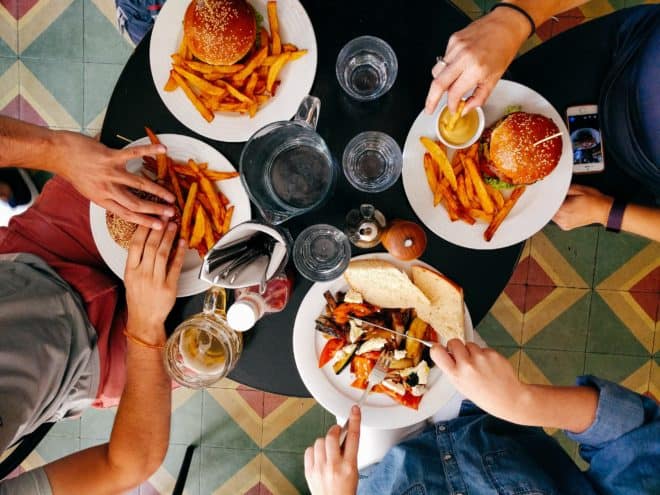Gimlet’s “Why We Eat What We Eat” is a branded podcast done right


Raise your hand if you’ve heard a Blue Apron ad read on one of your favorite podcasts. Ok, looks like everyone has their hands raised.
Blue Apron is far from a stranger to the podcasting world. As one of the pioneers in the at-home food kit space, they quickly identified podcasts as a profitable medium for their ads. For a few years, it seemed like they advertised on nearly every podcast I listened to. If they didn’t, it sure felt like it. But with their latest endeavor, they’re taking the more nuanced approach. They’ve partnered with Gimlet Creative on a branded podcast, Why We Eat What We Eat, a kind of food anthology hosted by food blogger and author Cathy Erway.
Blue Apron follows Gatorade, Tinder, and Microsoft with the branded podcast motion put on by Gimlet Creative, the advertising arm of Gimlet Media.
I’ll be the first to tell you, if you didn’t know Why We Eat What We Eat was a branded podcast by Blue Apron, you’d likely never know. There are no ads, no schilling, no corny “unboxing” of a Blue Apron package — it’s just an entertaining and interesting podcast about food culture. Recent episodes discuss the origin (and importance) of potlucks, how climate change may affect our diets, and why some people are prone to be picky eaters. On the Gimlet Creative website, it describes Why We Eat What We Eat as a podcast “for anyone who has ever eaten” and yeah, that makes sense.
I was fortunate enough to get connected to Cathy Erway and discuss the podcast, how she ventured from blogging to podcasting, and the relationship she has with both Gimlet and Blue Apron. Below is our discussion, lightly edited for clarity.
***
Kevin: With your history being a blogger and an author, can you walk us through how you migrated from strictly text-based medium to podcasts?
Cathy: Sure. It’s so funny when we think about blogging. It really was this new frontier that … We didn’t use the word back then, but it kind of disrupted print journalism and food journalism, because there’s suddenly all these food blogs. It was like this renegade writers and so forth. Food blogging has become, for better or for worse, a profession that you can earn a living off of rather than a space to be creative and share. I guess I’d like to say, authentic perspectives about food from an individual rather than some corporation.
Anyway, yeah. Having that background, it’s been fun to see how just the entire media world evolved throughout that time. Now we have social media. Instagram and Snapchat and all that stuff, but also podcasts. That’s a really exciting … I think that it’s the new frontier of when it comes to storytelling too. We’ve seen radio shows, and I’ve actually hosted a talk show podcast with a non-profit called Heritage Radio Network for a number of years. When we started in 2009, we didn’t see this whole podcast phenomenon coming on the way it has.
It’s really exciting to work on a narrative podcast with Gimlet because it is a sort of new area for me. I think it’s a really exciting space. I think it’s super engaging. It takes a lot of work. It’s very different from doing the live podcast format that I’m used to. There’s pros and cons to both of those, but, I think it all comes from that sense of charting new territory and finding new frontiers in media and food media in particular.
Kevin: That makes sense. When you were getting started, did you ever anticipate that you would get to where you are today, or was this always your career path?
Cathy: No, because wherever I am today didn’t really exist before! The blog was an alternate to become a food writer. Who knew that the tables would turn and becoming a blogger was a viable path on its own rather than being a freelance food writer and all those sort of glossy magazine jobs and editing jobs in food media are dissolving as we speak? Lot of changes.
I did want to be a writer, and I was obsessed with food, so that seemed where I wanted to go. And let me tell you. I’ve tried to do TV spots. People have tried to put me on cooking shows. I am terrible in front of the camera. I was like, “That’s not going to work for me.” So I’m really excited about working in podcasts. I was always really comfortable with the podcast and radio format. It’s just a lot of fun.
Kevin: Speaking of that, because you did make the transition from blogging to podcasting, was there any sort of training? Did you ever work on anything specifically so your thoughts could be translated better to an audio medium? Any voice training or anything like that?
Cathy: Training has been really on-the-job do-it-yourself figure-it-out training. It’s ironic because I’ve taught classes in food blogging, yet, at the time, we were sort of inventing the genre back in the early 2000’s, the early aughts, and so forth. Who trains who? You have to invent it.
When it came to podcasting, our objective [at Heritage Radio Network] was really different. We wanted to talk about important food issues, and a radio program seemed like an engaging format to do that and to get really cool experts and guests on air and hear them live and impromptu. My training has been simply doing it and figuring it out and adjusting as we go on. My Heritage Radio Network show has had a couple different evolutions and now, for the past few years, it is focused on food books. I found that it’s convenient because when people are on a book tour they want to get publicity. It’s easy to book people, especially when you’re the sole producer and everything of the show. Also, it’s a really great way to dig deep into a topic without having these pretenses of coming up with a theme and getting three or four different experts. You can really have that extended interview format, which is really nice.
Kevin: How do you balance the content on both your podcasts, Why We Eat What We Eat and Eat Your Words? Is there ever an overlap or conflict?
Cathy: Not really. There was a couple of times where I was thinking of having a guest on a show that I was like, “Oh, maybe she would be a great expert for ‘Why We Eat What We Eat‘”, but it didn’t really turn out that way. Working with Gimlet, there’s a lot of collaboration. The script changes a lot throughout the course of just a few days or a day of editing. We produce them with a team over a week or so. We’ll have some rough idea of each show, of each episode topic, but really it comes down to what kind of tape we get from the people that we interview. That leads our direction. We ended up, in some cases, leaving some tape on the editing room floor because some interviews just took us in a tangential way, and we decided to change direction and so forth.
It’s possible that there could be overlap, but it’s a really different format. It’s never going to be the same. One show is a story that is told through my narration and multiple people that we have speaking. “Eat Your Words” is a live, 30 minute conversation with an author. It’s totally different either way.
Kevin: How did you come to host “Why We Eat What We Eat”? Did Gimlet or Blue Apron hear and read your previous work and approach you, or was it something you pursued?
Cathy: They just approached me out of the blue. Out of the blue or not out of the blue, because, as we were saying before, it’s sort of like pursuing your passions and doing it for free eventually leads people to find what you’re doing. That’s what happened with my blog when I was approached by a publisher to write a memoir based on it, which came out in 2010. It’s “The Art of Eating In.”
I also had no idea that anyone would ever approach me to host a podcast, like with Gimlet. That they would actually pay me for it. That wasn’t even in my hopes. It was not on my radar. It’s the same case for when I started my blog. I had no idea that was going to happen. It just goes to show people will find what you’re doing if you do it with passion, if you do it because you mean it, because you just have to do it and you don’t care if you’re going to get paid for it.
Kevin: On that note, I think what Gimlet Creative is doing is especially well done because the podcast isn’t shelling any sort of product. If you didn’t already know it was a branded podcast, you likely wouldn’t realize. How is your relationship like with Blue Apron? What kind of partnership do they provide? Do they try to steer the editorial one way, or is it mostly like, “Hey. We hired great people to come up with great stories, and we’re just going to let them do what we do and consider us lucky that our name’s attached”?
Cathy: That’s a really great question, and that’s what my first question was when I was approached by Gimlet. For the record, I have no contact with Blue Apron for the process of making the show, but some producers of course do.
However, when Gimlet approached me about this, I was like, “So, aren’t they going to want to vet everything and be super involved with the creative process?” They were like, “Actually, no. It’s really not like that. They’ll look everything over and they’ll approve, etc. It’s really rare that they’ll have a problem.” They showed examples of their other branded podcasts, which was the Gatorade one, The Secret to Victory, and DTR, the Tinder one. I listened to them, and I was like, “Oh my gosh. This has nothing to do with these clients.” It’s like it’s brought to you by Gatorade, but then the show is about Serena Williams or something else. The same with DTR. It’s about relationships. It’s not about Tinder. It made a lot of sense.
I think that Blue Apron is a really great brand to bring about a modern food narrative show, because they really try to be that intimate company that tries to get in and go further, and get you involved in cooking from a personal … I mean, cooking is really personal, so I think it makes sense that they would want to have a show that speaks to not just cooking but why we eat what we eat. I thought it was really refreshing and honest.
Anyway, that said, Blue Apron does give feedback but we’ve had very little pushback or anything. It’s really cool, and I think that Gimlet is really paving the way for saying, “No. This is how sponsored podcasts should be. They shouldn’t sound like a commercial, because people won’t listen to it.” The clients are listening, and they get it. I think that’s awesome, because now they’re kind of setting the status quo, which is great. A really good status quo.
Kevin: It seems like an ideal partnership. As long as their content’s good without overtly selling anything, keep making them. I’m all for branded podcasts as long as it’s quality content. On the Gimlet side of the house, do you have any interaction with some of the other Gimlet shows, producers, hosts? Is there some sort of Gimlet knowledge-share out there?
Cathy: I’m sure there is. We shared the same recording booth. When our time is up, somebody is always kicking us out because they’re booked up every single minute of the day. But we’re working with Gimlet Creative, which is the arm of the company that does branded shows.
Given that, I don’t really have much reason to interact with other shows. Perhaps we will once the season dies down. It’s very all-hands-on-deck right now. Going through this six-episode season with each episode coming out a week after the other has been really intense. Once that dies down, hopefully we’ll have more mixers and get to mingle a bit more.
Kevin: That’ll be nice once it calms down a bit. I’m sure the production schedule is real hectic. In a past episode, you admitted your picky eater confession was avoiding cheese; however, you forced your way through a cheese tasting. Just wanted an update on that. How is the constant cheese reinforcement coming along?
Cathy: Once I have it in my head that I’m going to conquer something, I’m like, “I really should do this.” So I went through the rest of that cheese. I haven’t really seen … I haven’t been around blue cheese too much since, so it’s not something I’m actively doing. But next time I have an opportunity at somewhere, like at a party, I’m going to definitely make an effort [to eat blue cheese] this time rather than not.
That was a plot twist that just came up organically, too, during a meeting. That episode in particular was really fun, because it was going in all different directions. After a few conversations, it turned into, “Let’s go to Murray’s Cheese tomorrow.” Who knows where the episode is going to go after? I was like, “Oh God. I don’t want to make this about me.” But I think it was funny. I think it was funny how that turned out.
Kevin: It was definitely good to bring that side. Have you had a cheese curd yet?
Cathy: I love cheese curds.
Kevin: You love cheese curds? I had my first on last summer. I went to a wedding in the Midwest. I just couldn’t stand how they squeak in your mouth. It was just an odd sensation.
Cathy: It is kind of weird, but I love it. I love it because it doesn’t really taste weird. It’s the mildest. It’s just salty and mild. It’s totally within my safe range.
Kevin: Now, going into a speed round, what’s one podcast that you couldn’t live without or that’s on your must-listen on a weekly basis?
Cathy: I’ve been really dipping and dabbling around. It’s hard to say. I have been enjoying lately Still Processing with Jenna Wortham and Wesley Morris one. I like Reply All. I’ve been just listening to a lot of different things too, but those two I really do like.
Kevin: What surprised you about podcasting when you first started? Was there one thing that just stuck out to you that you weren’t expected?
Cathy: Yeah, just how much fricking work it is. How many people, how much time, how many hours of editing. Then there’s so many different roles. There’s the sound engineers. There’s the mixers. There’s the musicians who are coming up with original music to go with this. It’s really amazing. I realize that’s not always the case, this is Gimlet, but it’s really amazing to see how much goes into it…. Before Gimlet approached me, for the last several months before, I was trying to figure out how to hack out my own narrative podcast about food. I was working on this, and I was going around with a zoom recorder and trying to edit together things on my own and then write script and then narrate it. I was like, “Wow. This is going to sound like it’s such a bad effort if I don’t figure this out a little bit more. Also, this is going to take me like 100 years to make one episode if I try to do this on my own.”
Then, thank God, randomly, just coincidentally, Gimlet approached me out of the blue about their narrative food podcast. I’m like, “Hey. That sounds like almost just what I was trying to do.” It’s quite amazing. Now I’m even more like, “Wow.” It’s a lot more work than I even imagined.
Kevin: At brunch a couple weeks ago, we were ranking our top five favorite fruits and realized there’s not much of a consensus. Do you have a specific five that you like?
Cathy: Ha, um. Pineapple. I love apples. Mango. Watermelon. I love snow pears, Asian pears.













Comments
Comments are closed.